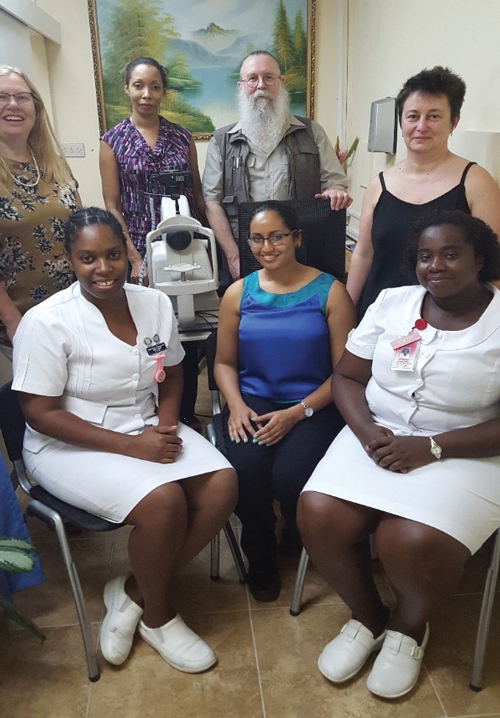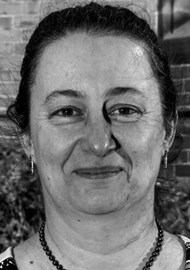At 2.55pm on Wednesday 16 March 2016 the first patient was screened and given her results in the new nurse-led Diabetic Retinopathy Screening (DRS) Clinic at the University Hospital of the West Indies (UHWI), Kingston, Jamaica.
This was the result of a collaborative LINK partnership between the UHWI and Homerton University Hospital / Moorfields Eye Hospital, established as part of the VISION 2020 LINKS Programme [1] and enabled by funding from the Queen Elizabeth Diamond Jubilee Trust [2].

Figure 1: Signing of the Memorandum of Understanding. CEO, UHWI, Kevin Allen (seated left) and Peter Mitchell (seated right). Witnessing the signing are (from left): Dr Lundie Richards (Ministry of Health); Minister of State in the Ministry of Finance and the Public Service, Fayval Williams; Dr Tunde Peto; Marcia Zondervan; Professor Horace Fletcher, Dean, Faculty of Medical Sciences at the University of the West Indies; Medical Chief of Staff, UHWI, Dr Carl Bruce; and Dr Lizette Mowatt.
The LINK was established in November 2014 and a formal Memorandum of Understanding (MoU) signed on 16 March 2016 (Figure 1). The LINK partnership was set to up to provide training and support f or the diabetic eye screening service and clinical, technical and managerial input necessary to set up a pilot scheme. This will act as a centre of excellence for training in diabetic retinopathy (DR) screening to help support the development of an island-wide (and ultimately Caribbean-wide) screening service.
The launch would not have been possible without the donation of a TRC NW6S fundus camera and technical support from Topcon and the ‘above and beyond’ help from Mark Evans of Topcon to make the camera / software operational just a day before the launch!
Background
Jamaica is classified by the World Bank as an upper middle income country [3], with GNI per capita of 5,150 USD in 2014 [4]. The population of Jamaica is approximately 2.8 million, of whom 1.7 million are adults. The prevalence of diabetes is 10.6% and the estimated number of people with diabetes (in 2013) is 178,500.
There are currently believed to be about 44,600 people with diabetes who are undiagnosed. A situation analysis in 2014 revealed that there was little in the way of public education about DR. The DR Network (DR-NET) as part of the VISION 2020 LINKS Programme, was established in 2014 to address the growing burden of DR across the Commonwealth [5]. It unites 17 VISION 2020 LINK partnerships developing DR screening and treatment services in 10 different countries including the Jamaica LINK partnership.
Some of the key people involved in the LINK and the development of DR services at the UHWI (Figure 2) have given their perspectives on the partnership and its achievements to date:
Figure 2: The UHWI-Homerton / Moorfields LINK team at the launch of the UHWI DR Screening Clinic. Back row, left to right: Marcia Zondervan, Lizette Mowatt, Peter Mitchell, Tunde Peto. Front row, left to right: Rhona Ferguson, RN, Acting Sister (Eye Clinic & OT), UHWI Roshni Sawh, Jr Ophthalmology Resident, Hortene King, RN, Sister (Eye Ward), UHWI.
Clinical Lead – Dr Lizette Mowatt
The UHWI is pleased to be the 29th LINK formed through the VISION 2020 LINKS Programme and the first in the Caribbean. We welcome the input from Peter Mitchell from Homerton University NHS Trust and Dr Tunde Peto from Moorfields Eye Hospital who have taught our nurses and residents about screening and grading fundal images. Nurses and technicians from other hospitals and the Diabetes Association of Jamaica were invited to the teaching and benefited greatly from their participation.
This DRS launch has been over two years in the making, from the first contact with Marcia Zondervan, VISION 2020 LINKS Programme Manager and exchange of emails in early 2014, to the first visit of the Jamaican UHWI-Ministry of Health (MoH) group in November 2014 to the London School of Hygiene & Tropical Medicine and to the Homerton DR Screening Clinic, London, England.
The Jamaican UHWI-MoH team to London comprised the UHWI Consultant Endocrinologist, Professor Rosemarie Wright-Pascoe, an Ophthalmic Nurse (Acrifa Fears), two representatives from the MoH and myself (UHWI Consultant Ophthalmologist). We attended a very informative DR workshop with the other LINKS from Africa, Indonesia and Fiji [5]. We also met the managers of the DR Screening Clinic at the Homerton University Hospital NHS Trust – Louis Bolter and Peter Mitchell – with whom the UHWI is linked, alongside Tunde Peto of Moorfields Eye Hospital, London. The partnership began and our three-year activity plans were laid.
In June 2015 the UK partner team – including Marcia Zondervan, Peter Mitchell, Louis Bolter, Chris Canning (from Moorfields Eye Hospital) and Zhara Gregory visited the eye clinic, UHWI, Jamaica to do a needs assessment. There was much to be accomplished. The DR screening room was identified and in July 2015 the refurbishment began.
We thank Topcon for their donated refurbished TRC NW6S camera which was received by the UHWI in September 2015. Plans were then stepped up to start the training process as the protocols to set up the new DR services were well underway. Plans were put in place for the proposed launch of our DR Screening Clinic in March 2016, alongside the next visit from the LINKS team.
In October 2015, with funding from the Queen Elizabeth Diamond Jubilee Trust, three members of the UHWI team (two nurses and an ophthalmologist) started a one-year online training course for Certification in Higher Education in DR from the University of Gloucestershire and Gloucestershire Hospitals NHS Trust.
The following month UHWI sent its team of two nurses and an ophthalmologist to visit the DR Screening Clinic at Homerton University Hospital, attend a two-day DRS training course at Moorfields Eye Hospital and a Programme Manager’s Course in Birmingham. In March 2016, two weeks prior to our Jamaican DR launch, we welcomed Dr Roshni Sawh, our year one ophthalmology resident to the team. With the assistance of the LINKS Programme, she was also registered to start the online training course.
With multiple meetings over the past two years and working closely with our managers, Mrs Barbara Garcia and Mr Lloyd Butler, and UHWI administration, we have finally set up the new DR Screening Clinic. This was launched and screening commenced on 16 March 2016, on schedule with all members of the visiting LINK partner team present – Tunde Peto, Peter Mitchell, Marcia Zondervan – working hard to make this happen (Figure 1). The signing of the MoU was on the same day, with the representatives of the Ministry of Health and Member of Parliament, Dean of the Faculty of Medicine, UHWI Senior Director of Clinical services and Chief Executive Officer (UHWI) being present. They then had a tour of our new DRS room, with the Member of Parliament having her eyes screened during that visit (Figure 3).

Figure 3: Demonstrating the Topcon fundus camera. Minister of State in the Ministry of Finance and the Public Service Fayval Williams (seated) looks at the fundal photograph using the fundus camera donated to the University Hospital of the West Indies (UHWI). Sharing in the moment are (from left): Dr Tunde Peto, Professor Horace Fletcher, Kevin Allen, Rhona Ferguson, Dion Murphy Nedrick, (Nursing Director), George Planto (Councillor-caretaker for the Papine Division) and Dr Roshni Sawh.
In the coming year we plan to assist the training of screeners and graders island-wide as the Government of Jamaica rolls out its nationwide DR screening programme. The latter has also been supported by the Queen Elizabeth Diamond Jubilee Trust. With continued monitoring, auditing and working with our LINK partner we hope to continue improving and also to develop a second DR screening clinic, in the Diabetes Clinic at UHWI, within the next one to two years as we train more technicians.
The activities this week are part of a historical event at the UHWI in Jamaica with the development of DR screening to detect disease and implement treatment earlier. We also plan to include educational sessions for all patients attending our DR screening clinic, with the aim of reducing the modifiable risk factors (diet, exercise and increased compliance with their medication).
With the most recent visit of the LINK team in March 2016, we have significantly increased awareness of the need for DR screening in our country both amongst the medical professionals and our patients. There was media coverage of this event on both local television stations and in local newspapers, including our Signature Event on the ‘Significance of Diabetic Retinopathy in Jamaica’ held at the UHWI on 14 March 2016 [6-8].
We look forward to the day when DR will no longer be the leading cause of visual impairment in the working age group in our country. This first step was possible with the collaborative efforts of the VISION 2020 LINKS Programme, Homerton University NHS Trust, Moorfields Eye Hospital and the UHWI, together with funding from the Queen Elizabeth Diamond Jubilee Trust.
Training Lead – Dr Roshni Sawh
It is my privilege as the newest member of the UHWI DR screening programme to be given this life-changing opportunity and become involved in the medical education that will one day be beneficial to all diabetic patients in Jamaica. I have had important skills and guidance in the running of the clinics shared with me by the enthusiastic teachers from the VISION 2020 LINK. With the collaboration of the other hospitals in the island, I look forward to achieving my goal of preserving vision and reducing blindness and physical disability in the Jamaican population, starting with people affected by diabetes.
The LINK is invaluable to the enhancement of UHWI management of diabetic patients. We will continue to work together and implement future development plans for the region of Kingston and St Andrew and intend for eventual expansion of our programme to include other hospitals in Jamaica.
The typical Jamaican person consumes a diet rich in fat and sugar. Many of the food choices available have very little nutritional value but are favoured by the Jamaican population because they appeal to the palate and are affordable. Most individuals are unaware that the food that they are eating is detrimental to their health. It is no wonder that within our population there is a growing number of patients with type 2 diabetes. This is a public health issue that we are trying to address through this LINK and through education of all patients and their relatives.
Nurse Screener – Nurse Rhona Ferguson
Through the LINK we (Nurse Hortene King and I) had the opportunity to travel to London in November 2015 to visit the Homerton DR Screening Clinic and watch how it operated. This partnership is beneficial as we are now equipped with a fundus camera as well as being trained to grade images through the University of Gloucestershire online course. This has been a wonderful experience as it is the first nurse-led DR clinic in Jamaica.
UK LINK Trainer – Dr Tunde Peto
It has been an absolute pleasure to be involved in this LINK partnership. As a consultant ophthalmologist at Moorfields specialising in medical retina I am fully aware of the implications of having no DR screening in a country. When we started screening in the UK, diabetes was the most common cause of blindness in the working age-group in the UK, and after 10 years of organised screening that is no longer the case! I can see that the same can potentially happen in Jamaica once island-wide screening is provided to all patients with diabetes. Using this VISION 2020 LINK partnership opportunity with funding provided by the Queen Elizabeth Diamond Jubilee Trust to enable collaboration between institutions and co-operation island-wide, I am positive that diabetic eye care will improve and in years to come will have a major effect on the number of people going blind, especially in the working age-group. We are involved for the long-term to assist this LINK going forward.
UK LINK Trainer – Peter Mitchell
As clinical manager of one of the largest DR screening services in the UK that covers the whole of London North East this has been a wonderful opportunity to share my 10 years of experience in running the clinical aspects of eye screening. This is such an exciting project. The impact of poorly managed diabetes on sight is devastating for the individual, the family and the community. In the decade of running a National Diabetic Retinopathy Service we have seen sight loss from diabetes in the working age population fall from being the number one cause to number two. We have learnt many lessons over the last ten years and we hope to be able to help Jamaica learn from some of the successes and pitfalls that we encountered. This is a long-term project and I look forward to a long-term partnership.
Operations Manager, UHWI – Barbara Garcia
We welcome this new clinic – an opportunity to improve the ophthalmic services we offer. With the incidence of diabetes that we’re facing in our population, we anticipate that the clinic will be well supported. We look forward to being able to positively impact outcomes on the prevalence of retinopathy in our diabetic patients.
UK LINK Diabetes Specialist Nurse – Zhara Gregory
As a diabetes specialist nurse who has worked in an ophthalmology department at Moorfields Eye Hospital and is now part of the grading team at Homerton University Hospital, I have been able to communicate the importance of using eye screening encounters as opportunities to educate the patients in how to manage their diet and exercise to better manage their diabetes and consequently impact on the risks for sight loss. On this training visit to Jamaica I am providing lots of material that can be included in patient education videos that will be played in the clinic waiting rooms.
Now and the future
The present status of diabetic retinopathy at UHWI shows that 50.5% and 19% of patients have proliferative diabetic retinopathy (PDR) and diabetic maculopathy respectively [6]. This has a significant impact on the hospital resources, as 34% of patients with PDR have tractional retinal detachments requiring surgical intervention.
Our patients have a 45-70% compliance with their diabetic medications and 81% of patients are obese, with a median body mass index (BMI) of 29.1, (16.6-47.4) kg/m2) [6,7,8]. Only 23% of our patients had good blood glucose control [HbA1c < 6.5%] [7]. Although they have good knowledge about diabetes, their knowledge, beliefs and practices were not well correlated. Over 95% of patients know that diet and exercise are important, however, only 49.7% and 40.3% had a special diet and exercised regularly, respectively.
There is great need for further continuing education, screening, early detection and treatment of diabetic retinopathy in our country. Jamaica needs to focus its efforts on reducing preventable blindness, as the 29th LINK we have started the process. The UHWI has, with the assistance of VISION 2020 LINKS, started training the screeners and graders and hopes to be a beacon of light for training and guidance as the DRS becomes an island wide service. This has been through the funding of the Queen Elizabeth Diamond Jubilee Trust (QEDJT) which continues to assist commonwealth countries in reducing avoidable blindness. We hope that with this programme, in another 10 years diabetic retinopathy will no longer be our leading cause of visual loss in our young working population.
References
1. VISION 2020 LINKS programme. International Centre for Eye Health.
http://iceh.lshtm.ac.uk/
vision-2020-links-programme/
Last accessed April 2016.
2. The Queen Elizabeth Diamond Jubilee Trust.
http://jubileetribute.org/
Last accessed April 2016.
3. Country Income Groups (World Bank Classification). ChartsBin.
http://chartsbin.com/view/2438
Last accessed April 2016.
4. Jamaica. The World Bank.
http://data.worldbank.org/country/jamaica
Last accessed April 2016.
5. Poore S, Foster A, Zondervan M, et al. Commonwealth nations join forces to prevent blindness from diabetes. Eye News 2015;21(5):33-6.
6. Mowatt L. Diabetic retinopathy and its risk factors at the university hospital in Jamaica. Middle East Afr J Ophthalmol 2013;20(4):321-6.
7. Duff EM, O’Connor A, McFarlane-Anderson N, et al. Self-care, compliance and glycaemic control in Jamaican adults with diabetes mellitus. West Indian Med J 2006;55(4):232-6.
8. Foster T, Mowatt L, Mullings J. Knowledge, Beliefs and Practices of Patients with Diabetic Retinopathy at the University Hospital of the West Indies, Jamaica. J Community Health 2015 Dec 18. [Epub ahead of print]

COMMENTS ARE WELCOME









